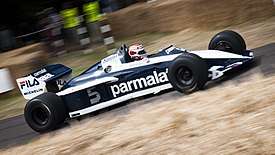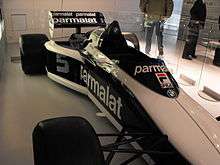Brabham BT52
The Brabham BT52 was a Formula One car designed for the Brabham team by longtime Brabham designer Gordon Murray for the 1983 season. The car ran on Michelin tyres and was powered by the massively powerful BMW M12/13 turbocharged engine which in 1983 produced a maximum of approximately 800 bhp (600 kW) in qualifying trim, detuned to around 640 bhp (480 kW) for the races proper. Its drivers were 1981 World Champion Nelson Piquet and Riccardo Patrese.[4]
 A Brabham BT52 at the 2013 Goodwood Festival of Speed. | |||||||||
| Category | Formula One | ||||||||
|---|---|---|---|---|---|---|---|---|---|
| Constructor | Brabham | ||||||||
| Designer(s) | Gordon Murray | ||||||||
| Predecessor | BT50 | ||||||||
| Successor | BT53 | ||||||||
| Technical specifications[1][2] [3] | |||||||||
| Chassis | Carbon fibre monocoque with rear subframe | ||||||||
| Suspension (front) | Double wishbones, push-rod operated coil springs over dampers | ||||||||
| Suspension (rear) | Double wishbones, push-rod operated coil springs over dampers | ||||||||
| Axle track | BT52: Front: 1,778 mm (70.0 in) Rear: 1,657 mm (65.2 in) BT52B: Front: 1,753 mm (69.0 in) Rear: 1,651 mm (65.0 in) | ||||||||
| Wheelbase | BT52: 2,860 mm (113 in) BT52B: 2,845 mm (112.0 in) | ||||||||
| Engine | BMW M12/13, 1,499 cc (91.5 cu in), Straight 4, turbo, mid-engine, longitudinally mounted | ||||||||
| Transmission | Brabham/Hewland 5/6-speed manual Weismann Differential | ||||||||
| Weight | 540 kg (1,190 lb) | ||||||||
| Fuel | Castrol | ||||||||
| Tyres | Michelin | ||||||||
| Competition history | |||||||||
| Notable entrants | Fila Sport Brabham BMW | ||||||||
| Notable drivers | 5. 6. | ||||||||
| Debut | 1983 Brazilian Grand Prix | ||||||||
| |||||||||
| Constructors' Championships | 0 | ||||||||
| Drivers' Championships | 1 (1983, Nelson Piquet) | ||||||||
History
After the ground effect cars were banned at the end of the previous season, the FIA mandated that all F1 cars be designed with flat undersides for safety reasons. With just 6 weeks until the opening race in Brazil, this left Brabham with three fully built BT51's ready to go that were now useless, so Murray started from scratch and he designed the BT52. The previously crucial sidepods were now generating lift rather than suction and so the BT52 had short, angular sidepods to keep lift at a minimum. Murray also took a gamble and moved approximately 70% of the cars weight to the rear in an effort to obtain more traction. The car featured a distinctive dart-shaped profile and oversized rear wing in an effort to claw back as much downforce as possible, while the monocoque was built from aluminium and carbon fibre composite to keep weight as low as possible. The 1983 season saw refueling stops reintroduced after successful experiments in 1982 so the BT52's fuel system was designed with this in mind and had a small fuel tank positioned high up behind the driver.[5]
The car was easy to drive and Piquet used it to good effect that season. Fighting with Alain Prost in the Renault and René Arnoux of Ferrari, it seemed he would lose out on the title after a run of mid season bad luck. But after German company Wintershall developed a special batch of fuel and further development to the car was done, he became the first driver to win the world championship with a turbo engine after winning three races, Brazil (Rd.1), Italy (Rd.13) and European (Rd.14), and scoring consistently with three 2nd and two 3rd places. Patrese on the other hand seemed to corner the market on Brabham's bad luck and while often as quick or quicker than Piquet (including leading the San Marino Grand Prix before crashing out with only 6 laps remaining, and grabbing pole at Monza) he didn't score a point until his third in Round 10 at the German Grand Prix. His only other points finish being his win at the season ending South African Grand Prix at Kyalami.[6]
With Piquet winning his second World Drivers' Championship with 59 points, and Patrese finishing 9th on 13 points, Brabham finished third in the Constructors' Championship with 72 points, 7 behind second placed Renault and 17 behind winners Ferrari.
The BT52 was updated after the Canadian Grand Prix to the BT52B and proceeded to win three of the remaining seven races of the season. The two variants of the chassis can easily be distinguished as the colour scheme was also reversed at the same time. A further update came later in the season when Brabham adopted the Ferrari style 'winglets' on the rear wing in order to generate more downforce. The BT52 was replaced for the 1984 Formula One season by the Brabham BT53.[7]
Complete Formula One World Championship results
(key) (Races in bold indicate pole position; races in italics indicate fastest lap)
| Year | Entrant | Chassis | Engine | Drivers | 1 | 2 | 3 | 4 | 5 | 6 | 7 | 8 | 9 | 10 | 11 | 12 | 13 | 14 | 15 | Pts | WCC |
|---|---|---|---|---|---|---|---|---|---|---|---|---|---|---|---|---|---|---|---|---|---|
| 1983 | Fila Sport Brabham BMW | BMW M12/13 S4 tc |
BRA | USW | FRA | SMR | MON | BEL | DET | CAN | GBR | GER | AUT | NED | ITA | EUR | RSA | 72 | 3rd | ||
| BT52 | Nelson Piquet | 1 | Ret | 2 | Ret | 2 | 4 | 4 | Ret | ||||||||||||
| BT52B | 2 | 13 | 3 | Ret | 1 | 1 | 3 | ||||||||||||||
| BT52 | Riccardo Patrese | Ret | 10 | Ret | Ret | Ret | Ret | Ret | Ret | ||||||||||||
| BT52B | Ret | 3 | Ret | 9 | Ret | 7 | 1 |
References
- "STATS F1 • Brabham BT52". Statsf1.com. Retrieved 23 August 2010.
- "STATS F1 • Brabham BT52B". Statsf1.com. Retrieved 23 August 2010.
- "Brabham F1 Racecars Weismann Transaxles • Brabham BT52B". weismann.net. Archived from the original on 7 April 2010. Retrieved 3 November 2010.
- "Watch BMW Build The Most Powerful F1 Engine Ever - BT52 1,280 horsepower". 25 January 2017. Retrieved 13 December 2019.
- "TECH TUESDAY: The ground-breaking Brabham BT52". formula1.com. Retrieved 13 December 2019.
- "1983 Brabham BT52 BMW - Images, Specifications and Information". Ultimatecarpage.com. Retrieved 13 December 2019.
- "X-ray spec -- Brabham BT 52". Motor Sport Magazine. 7 July 2014. Retrieved 13 December 2019.
External links
| Wikimedia Commons has media related to Brabham BT52. |
| Awards | ||
|---|---|---|
| Preceded by Porsche 956 |
Autosport Racing Car Of The Year 1983 |
Succeeded by McLaren MP4/2 |

.jpg)

.jpeg)